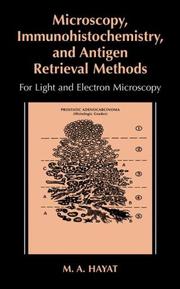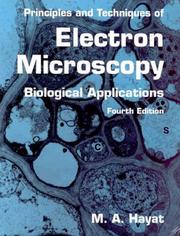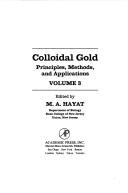| Listing 1 - 10 of 165 | << page >> |
Sort by
|
Book
ISBN: 128187115X 9786611871154 1402083696 1402083688 9048178584 Year: 2008 Publisher: [Dordrecht] : Springer,
Abstract | Keywords | Export | Availability | Bookmark
 Loading...
Loading...Choose an application
- Reference Manager
- EndNote
- RefWorks (Direct export to RefWorks)
This is the first book that discusses subjects of diagnosis, therapy, therapy assessment, and prognosis of breast cancer in one single volume. Cancer killed 6.7 million people around the world in 2002 and this figure is expected to rise to 10.1 million in 2020. Approximately, 189,510 new cases of breast cancer were reported in 2007 in the United States, and 40,910 died in the same year. Focusing on Breast Carcinoma, this first volume in the series Methods of Cancer Diagnosis, Therapy and Prognosis brings together 56 leading scientists from around the world to deliver a comprehensive treatise on all aspects of breast cancer, including diagnosis, treatments and prognosis. Scientists and clinicians have contributed state of the art chapters on their respective areas of expertise providing the reader a whole field view of breast cancer management. This fully illustrated volume: * Presents a constructive evaluation of commonly used methods for elucidating primary and secondary cancer initiation, progression, relapse, and metastasis. * Highlights methods of breast cancer diagnosis and treatment assessment including various imaging modalities such as ultrasound, computed tomography, magnetic resonance imaging, immunohistochemistry and histochemistry. * Discusses detailed therapeutic protocols, including both their benefits and side-effects. * Discusses examples of breast cancer treatments includingchemotherapy, radiation, chemoradiation, surgery, hormonal - and immunotherapy * Details the molecular processes that lead to the development and proliferation of cancer cells * Includes recent major advances in cancer diagnosis and therapy assessment Professor Hayat has summarized the problems associated with the complexities of research publications and has been successful in editinga must-read volume for oncologists, cancer researchers, medical teachers and students of cancer biology.
Breast --- Cancer --- Diagnosis. --- Treatment. --- Oncology. --- Oncology . --- Surgical oncology. --- Nursing. --- Radiotherapy. --- Cancer Research. --- Surgical Oncology. --- Radiation therapy --- Electrotherapeutics --- Hospitals --- Medical electronics --- Medical radiology --- Therapeutics, Physiological --- Phototherapy --- Clinical nursing --- Nurses and nursing --- Nursing process --- Care of the sick --- Medicine --- Oncologic surgery --- Oncological surgery --- Surgical oncology --- Tumors --- Radiological services --- Excision --- Treatment --- Cancer research. --- Cancer research
Book
ISBN: 128190418X 9786611904180 1402084420 1402084412 9048178835 Year: 2008 Publisher: Dordrecht : Springer Netherlands,
Abstract | Keywords | Export | Availability | Bookmark
 Loading...
Loading...Choose an application
- Reference Manager
- EndNote
- RefWorks (Direct export to RefWorks)
This is the first book that discusses the subjects of diagnosis, therapy, therapy assessment, and prognosis of lung and prostate cancer in one single volume. Cancer killed 6.7 million people around the world in 2002, and this figure is expected to rise to 10.1 million in 2020. Lung cancer has been the most common cancer in the world since 1985, and by 2002 there were 1.35 million new cases, representing 12.5% of all new cancers. It was also the most common cause of death from cancer, with 1.18 million deaths (17.6% of the world total). Lung cancer remains a highly lethal disease. After diagnosis, survival at 5 years in the United States is 15%. This second volume in the series Methods of Cancer Diagnosis, Therapy and Prognosis presents a comprehensive treatise on all aspects of Lung and Prostate cancer, including diagnosis, treatments and prognosis. Scientists and Clinicians have contributed state of the art chapters on their respective areas of expertise providing the reader a whole field view of lung and prostate cancer management. This fully illustrated volume * Discusses diagnosis using molecular genetics, various imaging modalities, tumor markers and tumor gene therapy * Discusses treatments such as chemotherapy, radiation, chemoradiation, hormonal therapy, immunotherapy, and surgery; and prognosis * Highlights both primary and secondary cancers, and explains the risk of cancer survivors developing other cancers. * Attempts to translate molecular genetics into clinical practice. Evidence-based therapy is included. * Discusses the role of histology and immunohistochemistry in differentiating between pleuropulmonary desmoid tumors and solid fibroustumors. * Discusses cancer stem cells, mutations, cancer vaccines, and personalized cancer medicine. Professor Hayat has summarized the problems associated with the complexities of research publications and has been successful in editinga must-read volume for oncologists, cancer researchers, medical teachers and students of cancer biology.
Oncology. --- Cancer --- Nursing. --- Radiotherapy. --- Diagnosis. --- Radiation therapy --- Electrotherapeutics --- Hospitals --- Medical electronics --- Medical radiology --- Therapeutics, Physiological --- Phototherapy --- Clinical nursing --- Nurses and nursing --- Nursing process --- Care of the sick --- Medicine --- Tumors --- Radiological services --- Oncology . --- Surgical oncology. --- Cancer Research. --- Surgical Oncology. --- Oncologic surgery --- Oncological surgery --- Surgical oncology --- Excision --- Treatment --- Cancer research. --- Cancer research
Book
ISBN: 9401793255 9401793247 Year: 2014 Publisher: Dordrecht : Springer Netherlands : Imprint: Springer,
Abstract | Keywords | Export | Availability | Bookmark
 Loading...
Loading...Choose an application
- Reference Manager
- EndNote
- RefWorks (Direct export to RefWorks)
This third volume in the series Tumor Dormancy, Quiescence, and Senescence discusses the role of tumor dormancy and senescence in a number of diseases, including breast cancer, ovarian cancer, and leukemia. The contents are organized under five subheadings: General Applications, Role in Breast Cancer, Role in Ovarian Cancer, Role in Leukemia and Role in Cardiovascular Disease. The first section includes basic information on the definition of dormancy, how cells become senescent, and what they do, along with an appraisal of the current state of research on dormancy. Section Two explores dormancy in breast cancer, including the progression of hormone-dependent mammary tumors after dormancy. Section Three details the resistance of Type II ovarian tumors, in which the resistant tumor cell population persists after chemotherapy in a state of dormancy, with recurrent tumors arising upon transformation of such dormant cells back to malignant growth. This section explains how lineage, histological subtypes, and grade influence the differential response of ovarian cancer resistance to platinum drugs. The fourth section explores leukemia, discussing regulation of the promyelocytic leukemia protein and its role in premature senescence. The final section explores the role of senescence and autophagy in age-related cardiovascular diseases, and the observation that autophagy seems to retard cardiac senescence. Like the two preceding volumes in the series, Volume 3 stands out for its comprehensive approach, its roster of some 26 expert contributors representing seven different countries and its up-to-date review of leading-edge technology and methods.
Tumors. --- Neoplasms --- Tumours --- Pathology --- Cysts (Pathology) --- Oncology --- Life sciences. --- Medicine. --- Life Sciences, general. --- Biomedicine general. --- Medicine/Public Health, general. --- Clinical sciences --- Medical profession --- Human biology --- Life sciences --- Medical sciences --- Physicians --- Biosciences --- Sciences, Life --- Science --- Biomedicine, general. --- Health Workforce

ISBN: 0442256760 Year: 1973 Publisher: New York (N.Y.): Van Nostrand
Abstract | Keywords | Export | Availability | Bookmark
 Loading...
Loading...Choose an application
- Reference Manager
- EndNote
- RefWorks (Direct export to RefWorks)
Enzymology --- Biological microscopy --- Enzymes. --- Microscopy, Electron. --- Electron microscopy --- -Enzymes --- Biocatalysts --- Ferments --- Soluble ferments --- Catalysts --- Proteins --- Microscopy --- Electron Microscopy --- Molecular Mechanisms of Pharmacological Action --- Technique --- Technique. --- Biocatalyst --- Enzyme --- Enzymes --- Microscopy, Electron

ISBN: 0306467704 9786610200870 1280200871 0306475995 Year: 2002 Publisher: New York Kluwer Academic/Plenum
Abstract | Keywords | Export | Availability | Bookmark
 Loading...
Loading...Choose an application
- Reference Manager
- EndNote
- RefWorks (Direct export to RefWorks)
Histochemistry deals with the activities of chemical components in cells, and immunohistochemistry addresses the function of cell types in tissue or organs, such as those leading to acceptance or rejection of grafts or organs. This book is a methods volume focusing on antigen retrieval, particularly methods used in disease-related antigens. Because the book is a methods volume and a lab manual, it will have an audience of pathologists, biochemists, and lab technicians.
Human histology. Human cytology --- Biological microscopy --- Immunology. Immunopathology --- Microscopy. --- Electron microscopy. --- Antigens. --- Microscopie --- Microscopie électronique --- Antigènes --- 611.018 --- Histology. Histogenesis. Tissue structure, formation and differentiation --- Human anatomy. --- Immunohistochemistry. --- Life sciences. --- Medicine. --- Oncology. --- Pathology. --- Immunohistochemistry --- Microscopy --- Electron microscopy --- Antigens --- Histocytochemistry --- Immunologic Tests --- Immunochemistry --- Investigative Techniques --- Biological Factors --- Diagnostic Imaging --- Optics and Photonics --- Diagnostic Techniques and Procedures --- Histological Techniques --- Cytological Techniques --- Biochemistry --- Chemicals and Drugs --- Histology --- Laboratory Techniques and Procedures --- Analytical, Diagnostic and Therapeutic Techniques and Equipment --- Physics --- Immunologic Techniques --- Clinical Laboratory Techniques --- Natural Science Disciplines --- Biological Science Disciplines --- Chemistry --- Diagnosis --- Anatomy --- Disciplines and Occupations --- Microbiology & Immunology --- Biology --- Health & Biological Sciences --- 611.018 Histology. Histogenesis. Tissue structure, formation and differentiation --- Medicine & Public Health. --- Anatomy. --- Life Sciences, general. --- Analysis, Microscopic --- Light microscopy --- Micrographic analysis --- Microscope and microscopy --- Microscopic analysis --- Optical microscopy --- Optics --- Immunohistology --- Histochemistry --- Immunity --- Immunoglobulins --- Oncology . --- Biosciences --- Sciences, Life --- Science --- Disease (Pathology) --- Medical sciences --- Diseases --- Medicine --- Medicine, Preventive --- Tumors --- Anatomy, Human --- Human biology --- Human body

ISBN: 0306442949 9780306442940 Year: 1993 Publisher: New York Plenum Press
Abstract | Keywords | Export | Availability | Bookmark
 Loading...
Loading...Choose an application
- Reference Manager
- EndNote
- RefWorks (Direct export to RefWorks)
The author's primary aim is to thoroughly explain the biochemical concepts governing cytochemical procedures for transmission electron microscopy. Such information provides undergraduate and graduate students, technicians, and researchers with a more profound understanding of electron micrographs, as well as the knowledge to refine existing techniques and develop new methodologies.
Biological microscopy --- Microscopy, Electron --- Stains and Staining --- Electron microscopy --- Stains and Staining (Microscopy) --- Microscopie électronique --- Coloration (Microscopie) --- methods --- Technique --- Stains and staining (Microscopy) --- Technique. --- Stains and staining (Microscopy). --- Microscopie électronique --- methods. --- Staining (Microscopy) --- Microtechnique --- Electron microscopes --- Electron microscopy - Technique.

ISBN: 0521632870 9780521632874 Year: 2000 Publisher: Cambridge: Cambridge university press,
Abstract | Keywords | Export | Availability | Bookmark
 Loading...
Loading...Choose an application
- Reference Manager
- EndNote
- RefWorks (Direct export to RefWorks)
Principles and Techniques of Electron Microscopy has established itself as a standard book for biological electron microscopists wishing to learn how to prepare their specimens for electron microscopic investigation. This fully revised and expanded 4th edition includes three new chapters covering such topics as immunocytochemistry and applications of microwave irradiation to microscopy. This revised and expanded 4th edition of Principles and Techniques of Electron Microscopy provides practical instructions on how to process biological specimens, as well as a detailed discussion on the principles underlying the various processes. The book presents methods in a self-explanatory form. Further, alternative procedures and points of disagreement help the reader interpret data accurately. What sets this book apart from its competition is that it not only describes techniques but also explains the principles behind the techniques; that is, chemical reactions underlying the use of various reagents for preserving and staining cellular components.

ISBN: 0123339278 0123339286 0123339294 0323138810 0323139027 0323139019 9780123339270 9780123339287 Year: 1989 Publisher: New York (N.Y.) Academic press
Abstract | Keywords | Export | Availability | Bookmark
 Loading...
Loading...Choose an application
- Reference Manager
- EndNote
- RefWorks (Direct export to RefWorks)
Since its introduction in 1971, the development and application of colloidal gold as a marker in electron microscopy has been phenomenal. This state-of-the art, multi-volume treatise provides researchers, technicians, teachers, and students with the most comprehensive coverage of the principles and methodology of colloidal gold microscopy available today. Colloidal gold allows high and low resolution studies, enzyme and nucleic acid labeling, study of dynamic cellular processes, and virus detection. This third volume completes Hayat's coverage of the principles and methodology of colloidal gold in microscopy. The three-volume set should become the standard reference in the field. Key Features * Among the first books to cover principles and methodology of colloidal gold in microscopy * Describes methods step by step to enable researchers to learn these complex procedures solely by reference to the book * Discusses problems and limitations of techniques * Guides users to avoid problems and choose the correct procedures for specific applications * Contributors are eminent authorities in their fields Topics covered in Volume 3 include: * Production of monoclonal and polyclonal antibodies * Lowicryl, polar, and apolar resins * Preserving and localizing antigenicitysectioninghigh-resolution morphological localization * Diaminobenzidine-colloidal goldmicroinjection of colloidal golddouble labeling with backscattered electronsmicrowave irradiation * Applications to biomedical studies * Colloidal gold in conjunction with video-enhanced microscopy
Proteins --- Microscopy --- Immunocytochemistry --- Immunogold labeling --- Colloidal gold --- Gold Colloid, Radioactive --- Analysis --- Technique --- Gold Colloid, Radioactive. --- -Colloidal gold --- -Proteins --- -Proteids --- Biomolecules --- Polypeptides --- Proteomics --- Analysis, Microscopic --- Light microscopy --- Micrographic analysis --- Microscope and microscopy --- Microscopic analysis --- Optical microscopy --- Optics --- Immuno-gold labeling --- Immuno-gold probes --- Immunogold probes --- Labeling, Immunogold --- Probes, Immunogold --- Electron microscopy --- Immunohistochemistry --- Gold colloid --- Colloids --- Gold --- Cytochemistry --- Immunochemistry --- Immunofluorescence --- Radio-Colloidal Gold --- Colloid, Radioactive Gold --- Gold, Radio-Colloidal --- Radio Colloidal Gold --- Radioactive Gold Colloid --- Colloidal gold. --- Immunogold labeling. --- Technique. --- Analysis. --- -Technique --- -Immuno-gold labeling --- Proteids --- Immunology. Immunopathology --- Biochemical engineering --- Biological microscopy --- -Radio-Colloidal Gold --- Proteins - Analysis --- Microscopy - Technique --- Immunocytochemistry - Technique
Book
ISBN: 9400729561 9786613697707 1280787317 940072957X Year: 2012 Publisher: Dordrecht [Netherlands] : Springer,
Abstract | Keywords | Export | Availability | Bookmark
 Loading...
Loading...Choose an application
- Reference Manager
- EndNote
- RefWorks (Direct export to RefWorks)
Pediatric Cancer: Teratoid/Rhabdoid, Brain Tumors, and Glioma · Epilepsy prognosis and treatment · Symptoms of tumors in children · Diagnostic imaging technology This second volume in the Pediatric Cancer series edited by Professor M.A. Hayat presents a general introduction to the principles of diagnosis and treatment of children with brain tumors. *Cancer is the leading cause of death by disease among U.S. children between infancy and age 15. Approximately 11,210 new cases of pediatric cancer are expected to be diagnosed in children 0–14 years of age in 2011. A complete resource for researchers in the symptoms of tumors in children, epilepsy prognosis and treatment and diagnostic imaging technology, this volume presents and discusses: · Molecular characterization of solid tumors, · The role of molecular pathways providing putative targets for new therapies. · High resolution magic angle spinning NMR spectroscopy, to determine metabolic profiles for small pieces of intact tissue and whole cells in culture, · The differences between adult and pediatric brain tumors, · The role of tumor suppressor genes and oncogenes in the development and progression of human malignancies, · Various neuroradiological imaging modalities in children with leukemia, This volume also examines in detail the results of clinical trials using radiotherapy in pediatric brain tumors, such as medulloblastoma, ependymoma, craniopharyngioma, low-grade glioma, high-grade glioma, brainstem glioma, and germ cell tumors. Aimed at researchers and medical oncologists, Pediatric Cancer volume 2, will also be of interest to medical technicians, pharmaceutical companies and of course, medical libraries. Professor M.A. Hayat is Distinguished Professor at the Department of Biology, Kean University NJ, USA. *National Cancer Institute, National Institutes of Health, U.S. Department of Health and Human Services http://www.cancer.gov/aboutnci/servingpeople/cancer-statistics/snapshots .
Cancer in children. --- Age Groups --- Neoplasms, Neuroepithelial --- Central Nervous System Neoplasms --- Neoplasms, Complex and Mixed --- Neoplasms, Germ Cell and Embryonal --- Brain Diseases --- Neuroectodermal Tumors --- Persons --- Nervous System Neoplasms --- Neoplasms, Glandular and Epithelial --- Central Nervous System Diseases --- Neoplasms by Histologic Type --- Neoplasms --- Named Groups --- Nervous System Diseases --- Neoplasms, Nerve Tissue --- Neoplasms by Site --- Diseases --- Adolescent --- Child --- Brain Neoplasms --- Glioma --- Teratoma --- Rhabdoid Tumor --- Infant --- Medicine --- Health & Biological Sciences --- Oncology --- Teratocarcinoma. --- Brain --- Gliomas. --- Tumors. --- Teratoid carcinoma --- Medicine. --- Cancer research. --- Radiology. --- Oncology. --- Pediatric surgery. --- Surgical oncology. --- Biomedicine. --- Cancer Research. --- Pediatric Surgery. --- Imaging / Radiology. --- Surgical Oncology. --- Cancer --- Oncologic surgery --- Oncological surgery --- Surgical oncology --- Pediatric surgery --- Surgery, Pediatric --- Children --- Tumors --- Radiological physics --- Physics --- Radiation --- Cancer research --- Clinical sciences --- Medical profession --- Human biology --- Life sciences --- Medical sciences --- Pathology --- Physicians --- Excision --- Treatment --- Nervous system --- Surgery. --- Radiology, Medical. --- Oncology . --- Clinical radiology --- Radiology, Medical --- Radiology (Medicine) --- Medical physics --- Surgery, Primitive
Book
ISBN: 9400728999 9786613697653 9400729006 1280787260 Year: 2012 Publisher: Dordrecht [Netherlands] : Springer,
Abstract | Keywords | Export | Availability | Bookmark
 Loading...
Loading...Choose an application
- Reference Manager
- EndNote
- RefWorks (Direct export to RefWorks)
The fifth volume in the essential series on stem cell biology provides a detailed explanation of the mechanisms of self-renewing cancer stem cells, as well as their ability to generate the heterogeneous lineages of cancer cells that comprise tumors. It explores the unique resistance of cancer stem cells to conventional chemotherapy techniques able to kill a tumor’s constituent cells. The contents also include a discussion of the myriad applications of a selection of stem cells in treating disease and tissue injury. The cells singled out include human mesenchymal, arterial, neural, cardiac, dental, limbal, and hematopoietic stem cells. The therapeutic utility of uniquely adaptable human embryonic stem cells, able to generate any human cell type, is explored in depth. The volume looks at their uses in tissue engineering and regenerative medicine, as well as pharmacological, toxicological, and cell differentiation research. It also sheds light on the processes by which embryonic stem cells begin to differentiate by aggregating into more complex embryoid bodies. With additional material on targeting self-renewal pathways in cancer stem cells, the use of mesenchymal stem cells in treating ischemic brain injury, and the phenomenon of neural stem cell proliferation around traumatic brain injuries, this richly diverse and hugely informative book is a powerful tool for deepening professional expertise among researchers and practitioners in this field.
Cancer cells. --- Stem cells -- Therapeutic use. --- Stem cells -- Transplantation. --- Medicine --- Biology --- Health & Biological Sciences --- Oncology --- Cytology --- Medicine. --- Cancer research. --- Gene expression. --- Laboratory medicine. --- Neurosciences. --- Oncology. --- Pathology. --- Biomedicine. --- Cancer Research. --- Gene Expression. --- Laboratory Medicine. --- Medical laboratories. --- Oncology . --- Tumors --- Diagnosis, Laboratory --- Health facilities --- Laboratories --- Disease (Pathology) --- Medical sciences --- Diseases --- Medicine, Preventive --- Neural sciences --- Neurological sciences --- Neuroscience --- Nervous system --- Genes --- Genetic regulation --- Expression --- Clinical medicine --- Clinical pathology --- Diagnostic laboratory tests --- Laboratory diagnosis --- Laboratory medicine --- Medical laboratory diagnosis --- Diagnosis --- Pathology --- Cancer research --- Stem cells.
| Listing 1 - 10 of 165 | << page >> |
Sort by
|

 Search
Search Feedback
Feedback About UniCat
About UniCat  Help
Help News
News